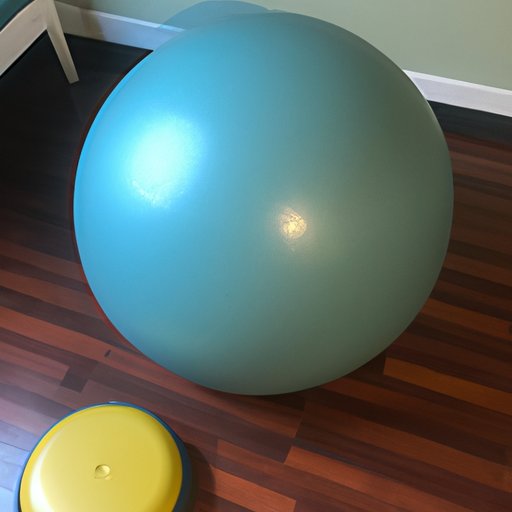Introduction
Exercise balls, also known as stability balls, balance balls, Swiss balls, physio balls, and yoga balls, are versatile pieces of equipment used in various types of workouts. They come in different sizes and can be used for strength training, stretching, and balance exercises. But what size exercise ball is best for you? This article will explore the different sizes of exercise balls, how to choose the right one, and the pros and cons of each size.
How to Choose the Right Size Exercise Ball for Your Height and Weight
When choosing an exercise ball, it’s important to consider your height and weight. The general rule is that the ball should be large enough to support your weight when inflated to its maximum size. Generally, people who are between 5’0″ and 5’6″ should use a 55 cm ball, those who are between 5’7″ and 6’2″ should use a 65 cm ball, and those over 6’2″ should use a 75 cm ball. It’s important to note, however, that these are only general guidelines and that individual needs may vary.
To ensure you’re getting the right size, measure the diameter of the ball before purchasing. You can do this by measuring from one side of the ball to the other, not including the valve. When sitting on the ball, your thighs should be parallel to the floor. If your thighs are above or below parallel when sitting on the ball, it’s too big or small for you, respectively.
In addition to your height and weight, there are several other factors to consider when selecting the right size exercise ball. These include the type of exercises you plan to do and the level of difficulty you want to achieve. For example, if you’re doing strength training exercises, you may want to go with a larger ball to provide more stability and support. If you’re doing balance exercises, you may want to go with a smaller ball to make them more challenging.

The Pros and Cons of Different Exercise Ball Sizes
Different sizes of exercise balls have their own unique benefits and drawbacks. Smaller balls are ideal for beginners because they provide more stability and support. Larger balls, on the other hand, require more core strength and balance. They also provide more room for movement, making them better suited for advanced exercisers.
Smaller balls are easier to transport, store, and inflate, and they also take up less space. However, they may not be suitable for taller individuals or those who are particularly heavy. Larger balls, while providing more stability and support, can be difficult to move and store and require more effort to inflate.

The Best Exercise Ball Sizes for Different Exercises
The size of the exercise ball you use will depend on the type of exercises you plan to do. Here are some guidelines for selecting the right size exercise ball for different types of exercises:
Cardio Exercises
For cardio exercises such as bouncing, jumping, or jogging, a medium-sized ball (65 cm) is recommended. This size provides enough stability and support for most exercisers, while still allowing for plenty of movement.
Strength Training
For strength training exercises such as push-ups, squats, and planks, a larger ball (75 cm) is recommended. This size provides more stability and support, which is essential for these types of exercises.
Stretching and Balance
For stretching and balance exercises, a smaller ball (55 cm) is recommended. This size provides more challenge and requires more core strength and balance.

A Guide to Selecting the Perfect Exercise Ball Size for You
Choosing the perfect exercise ball size for you is an important decision that can make or break your workout. Here are some tips for selecting the right size for your needs:
- Determine your body type and size: Consider your height and weight to determine the optimal ball size for you.
- Measure the diameter of the ball: To ensure you’re getting the right size, measure the diameter of the ball before purchasing.
- Consider the material of the ball: Different materials offer different levels of support and stability. Make sure to select a ball that is comfortable and supportive.
- Choose the right size for your needs: Consider the type of exercises you plan to do and the level of difficulty you want to achieve when selecting the right size exercise ball.
It’s also important to remember that different sizes of exercise balls offer different levels of stability and support. So, make sure to select the right size for your needs and remember to always consult a doctor before starting any new exercise regimen.
Conclusion
Exercise balls are versatile pieces of equipment that can be used for a variety of exercises. Different sizes of exercise balls offer different levels of stability and support, so choosing the right size is essential. By considering your body type and size, measuring the diameter of the ball, and considering the type of exercises you plan to do, you can find the perfect size exercise ball for your needs.
(Note: Is this article not meeting your expectations? Do you have knowledge or insights to share? Unlock new opportunities and expand your reach by joining our authors team. Click Registration to join us and share your expertise with our readers.)
